No. 303: Inflation Update, Housing and Production
JOHN WILLIAMS’ SHADOW GOVERNMENT STATISTICS
COMMENTARY NUMBER 303
Inflation Update, Housing and Production
June 17, 2010
__________
May Annual Consumer Inflation:
2.0% (CPI-U), 9.2% (SGS)
Seasonal Factors Depressing Monthly CPI
Reverse in June and July
Early Signs Continue of Intensifying Business Contraction
__________
PLEASE NOTE: The next regular Commentary is scheduled for Friday, June 25th, following the release of the third estimate (second revision) of first-quarter 2010 GDP, and will include an assessment of the May new orders for durable goods and existing and new home sales released earlier in that week.
– Best wishes to all, John Williams
The Outlook Remains for Intensified Economic and Solvency Crises, Higher Inflation and Hyperinflation. The last two weeks have seen several early and still-tentative indications of an intensified downturn in economic activity, including a weak employment report (net of census hires) and monthly contractions in retail sales and housing starts that were not expected by consensus forecasters. Those data were for May. As discussed in Commentary No. 301 and numerous previous writings, an annual contraction in real (inflation-adjusted) broad liquidity (SGS-Ongoing M3) has been signaling the renewed economic difficulties since December 2009.
The primary exception to these negative market surprises was May industrial production, but production, too, should soften in the months ahead, along with most other numbers on business activity. Watch in particular for some negative surprises in the upcoming June employment and unemployment report, due for release on July 2nd. Significant jobs loss among the temporary census workers likely set the tone for the balance of the economy, along with an upturn in the unemployment rate.
As mounting signs of renewed economic deterioration push consensus forecasts towards the concept of an intensifying downturn or double-dip recession, the implications for same should have significant impact on the largely unsuspecting financial markets. Consensus forecasts for the federal budget deficit, U.S. Treasury funding needs and banking-system solvency all are based on assumptions of economic growth in 2010, not renewed contraction.
As the deficit and funding needs explode well beyond expectations, currency market focus likely will shift from the euro’s woes to those of the U.S. dollar, with massive selling of dollars and dollar-denominated paper forcing the Fed to act as lender of last resort to the U.S. Treasury. Those actions would spike the domestic money supply, from Treasury debt monetization, in conjunction with heavy dollar selling, triggering an early round of unusually high inflation. That, in turn, likely would evolve into hyperinflation. Once more, this is as previously discussed (see Hyperinflation Special Report, the opening comments in Commentary No. 297 and, again Commentary No. 301); it is just that some of the finer detail is beginning to come into focus.
The general outlook on the economy and the markets is unchanged. For those with assets at risk, circumstances continue to suggest looking at actions for long-range wealth preservation. Despite any severe near-term volatility in the markets, physical gold and silver, assets outside the U.S. dollar (such as the Canadian dollar, the Australian dollar and Swiss franc) and assets outside the United States, offer long-term hedges against the severe loss ahead in U.S. dollar’s purchasing power.
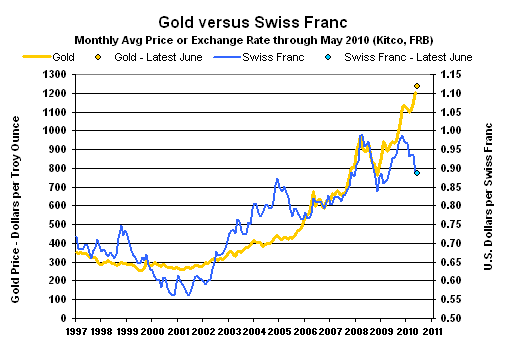
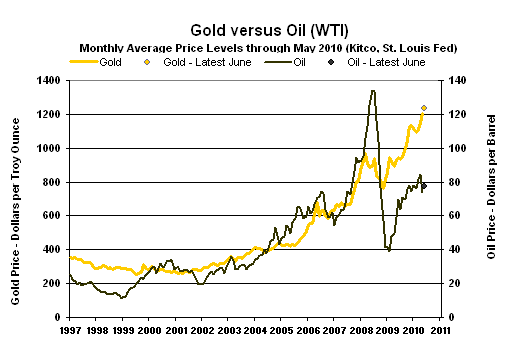
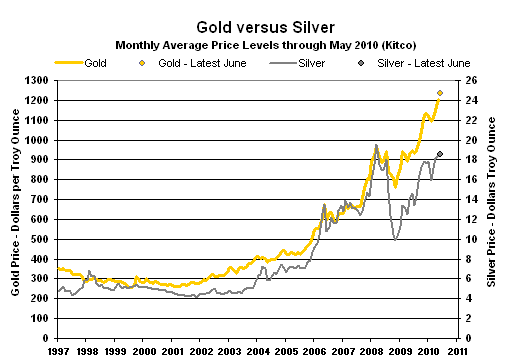
As suggested by the above graphs, the gold market continues to look beyond the short-term upside distortion in the U.S. dollar’s exchange rate and the downside distortion to oil prices.
Notes on Different Measures of the Consumer Price Index.
The Consumer Price Index (CPI) is the broadest inflation measure published by U.S. Government, through the Bureau of Labor Statistics (BLS), Department of Labor:
The CPI-U (Consumer Price Index for All Urban Consumers) is the monthly headline inflation number (seasonally adjusted) and is the broadest in its coverage, representing the buying patterns of all urban consumers. Its standard measure is not seasonally adjusted, and it never is revised on that basis except for outright errors,
The CPI-W (CPI for Urban Wage Earners and Clerical Workers) covers the more-narrow universe of urban wage earners and clerical workers and is used in determining cost of living adjustments in government programs such as Social Security. Otherwise its background is the same as the CPI-U.
The C-CPI-U (Chain-Weighted CPI-U) is an experimental measure, where the weighting of components is fully substitution based. It generally shows lower annual inflation rate than the CPI-U and CPI-W. The latter two measures once had fixed weightings—so as to measure the cost of living of maintaining a constant standard of living—but now are quasi-substitution-based. Since it is fully substitution based, the series tends to reflect lower inflation than the other CPI measures. Accordingly, the C-CPI-U is the "new inflation" measure being proffered by Congress and the White House as a tool for reducing Social Security cost-of-living adjustments by stealth. Moving to accommodate the Congress, the BLS announced pending changes to the C-CPI-U estimation and reporting process on October 22, 2014, which are described in Commentary No. 668
The ShadowStats Alternative CPI-U measures are attempts at adjusting reported CPI-U inflation for the impact of methodological change of recent decades designed to move the concept of the CPI away from being a measure of the cost of living needed to maintain a constant standard of living.
Those energy-related seasonal distortions, however, start to reverse in June, becoming neutral in that month, with reported energy inflation getting spiked sharply by the seasonals in July, irrespective of whatever is happening at the gas pump. Accordingly, the recent pattern of minimal monthly contractions in the seasonally-adjusted CPI should be at an end, at least for several months.
CPI-U. The BLS reported this morning (June 17th) that the seasonally-adjusted May CPI-U eased by 0.16% (up by 0.08% unadjusted) +/- 0.12% (95% confidence interval not seasonally adjusted) for the month, after a 0.07% decline (a gain of 0.17% unadjusted) in April. Seasonally-adjusted, the CPI-U annualized rate of inflation for the three months ended May 2010 (May versus February) was a decline of 0.67%, against April’s unchanged level. The lack of inflation in the latest three months, once again, was due to seasonal adjustments. Unadjusted, the CPI-U annualized rate of inflation for the three months ended May 2010 (May versus February) was 2.68%, against April’s 2.46%.
Unadjusted, May’s year-to-year inflation was 2.02% +/- 0.20% (95% confidence interval) against a 2.24% annual increase in April.
Year-to-year inflation would increase or decrease in next month’s June 2010 reporting, dependent on the seasonally-adjusted monthly change, versus the 0.71% adjusted monthly gain seen in June 2009. I use the adjusted change here, since that is how consensus expectations are expressed. To approximate the annual inflation rate for June 2010, the difference in June’s headline monthly change (or forecast of same) versus the year-ago monthly change should be added to or subtracted directly from May 2010’s reported annual inflation rate of 2.02%.
CPI-W. The narrower, seasonally-adjusted May CPI-W declined by 0.28% (gained 0.08% unadjusted) for the month, following a decline of 0.14% (a gain of 0.20% unadjusted) in April. Seasonally-adjusted, the annualized rate of CPI-W inflation for the three months ended May (May versus February) was a contraction of 1.42%, versus a decline of 0.03% in April. As with the CPI-U, the lack of inflation in the latest three months again was due to seasonal adjustments. Unadjusted, the CPI-W annualized rate of inflation for the three months ended May 2010 (May versus February) was 3.01%, against April’s 2.64%.
Unadjusted year-to-year CPI-W inflation rose by 2.56% in May, following a 2.90% April increase.
C-CPI-U. The Chain-Weighted CPI-U — the fully substitution-based series that gets touted by CPI opponents and inflation apologists as the replacement for the CPI-U — is reported only on an unadjusted basis. Year-to-year or annual inflation was 1.99% in May 2010, versus 2.33% in April. Unadjusted, the C-CPI-U annualized rate of inflation for the three months ended May 2010 (May versus February) was 2.73%, against April’s 2.40%.
Alternative Consumer Inflation Measures. Adjusted to pre-Clinton (1990) methodology, annual CPI inflation was roughly 5.4% in May 2010, versus 5.6% in April, while the SGS-Alternate Consumer Inflation Measure, which reverses gimmicked changes to official CPI reporting methodologies back to 1980, was about 9.2% (9.22% for those using the extra digit) in May, versus 9.5% in April.
The SGS-Alternate Consumer Inflation Measure adjusts on an additive basis for the cumulative impact on the annual inflation rate of various methodological changes made by the BLS. Over the decades, the BLS has altered the meaning of the CPI from being a measure of the cost of living needed to maintain a constant standard of living, to something that no longer reflects the constant-standard-of-living concept. Roughly five percentage points of the additive SGS adjustment reflect the BLS’s formal estimate of the impact of methodological changes; roughly two percentage points reflect changes by the BLS, where SGS has estimated the impact not otherwise published by the BLS.
Gold and Silver Highs Adjusted for CPI-U/SGS Inflation. Despite another recent all-time high in the price of gold, in the current cycle, gold and silver prices have yet to approach their historic high prices, adjusted for inflation. Even with the June 8th historic high gold price of $1,246.00 per troy ounce, the earlier all-time high of $850.00 (London afternoon fix, per Kitco.com) of January 21, 1980 was not breached in terms of inflation-adjusted dollars. Based on inflation through May 2010, the 1980 gold price peak would be $2,384 per troy ounce, based on not-seasonally-adjusted-CPI-U-adjusted dollars, and would be $7,595 per troy ounce in terms of SGS-Alternate-CPI-adjusted dollars.
In like manner, the all-time high price for silver in January 1980 of $49.45 per troy ounce (London afternoon fix, per silverinstitute.org) has not been hit since, including in terms of inflation-adjusted dollars. Based on inflation through May 2010, the 1980 silver price peak would be $139 per troy ounce, based on not-seasonally-adjusted-CPI-U-adjusted dollars, and would be $442 per troy ounce in terms of SGS-Alternate-CPI-adjusted dollars.
As shown on page 22 in the Hyperinflation report, over the decades, the price of gold has more than compensated for the loss of the purchasing power of the U.S. dollar as reflected by CPI-U inflation, while it has effectively fully compensated for the loss of purchasing power of the U.S. dollar based on the SGS-Alternate CPI.
Real Money Supply M3. The signal of pending intensification of the economic downturn, based on the annual contraction in the inflation-adjusted broad money supply (M3) most recently was discussed in Commentary No. 301. The annual real contraction in May M3 (SGS-Ongoing) estimated for that Commentary was 7.9%. Based on today’s CPI-U report, that annual contraction was 7.9%, deepened from April’s 7.0% contraction.
Real Retail Sales. Based on May 2010 CPI-U reporting, inflation- and seasonally-adjusted monthly May retail sales fell by 1.0%, where before inflation adjustment the current number was down by 1.2%, versus a 0.6% monthly real retail sales gain in April, the same as before inflation adjustment. May real retail sales rose at a 4.9% year-to-year pace — slower than in April — versus a 6.9% gain before inflation adjustment. Real April sales were up 6.6% year-to-year, versus a 9.0% gain before inflation adjustment.
Since November 2008, monthly real retail sales (CPI-U deflated) have been fluctuating around an average of $162.0 billion (the deflated May number was $166.9 billion). Smoothed for monthly volatility on a six-month moving-average basis, as shown in the accompanying graph, the pattern of activity here has been one of bottom-bouncing in terms of the level of inflation-adjusted sales. The recent bounce from short-lived stimulus factors and warped-seasonals appears to have run its course, with the average close to rolling over, with lower real sales levels likely in the months ahead. There has been no change in underlying fundamentals that would support a sustainable turnaround in economic activity — no recovery — just general bottom-bouncing.
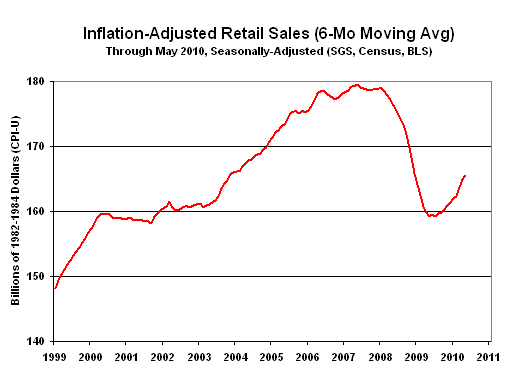
Unadjusted and year-to-year, May’s annual PPI inflation rate eased to 5.3% from the 5.5% annual gain reported for April.
On a monthly basis, seasonally-adjusted May intermediate goods rose by 0.4% (up by 0.8% in April), with crude May goods falling by 2.8% (down by 1.2% in April). Year-to-year inflation in May intermediate goods was up by 8.5% (up by 8.6% in April), with May annual inflation in crude goods up by 21.2% (up by 28.8% in April).
Year-to-year change in May was a statistically insignificant gain of 7.8% +/-11.3% (95% confidence interval), following a revised annual gain of 38.2% (previously 40.9%) in April. The extreme variation in annual growth patterns is due to the collapsing and troughing (April 2009 was the trough) of data a year ago, combined with the ongoing extreme volatility seen in these data in the current contraction.
Since December 2008, housing starts have been bottom-bouncing at an historically low level, averaging a seasonally-adjusted annual rate of 573,056. In the past 18 months, all monthly readings have been within the normal range of monthly volatility for the series around that average, including May 2010’s reading of 593,000.
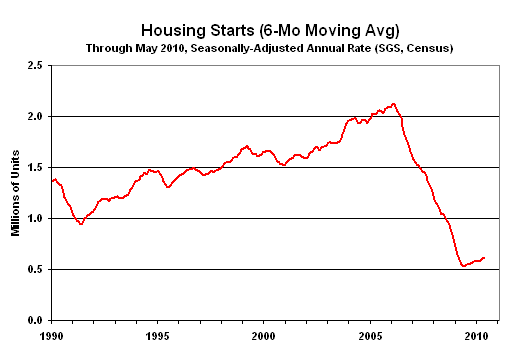
The "recovery" in housing is shown in the above graph. The data are smoothed using a six-month moving average to remove the extreme month-to-month volatility seen in this series. Regardless of any level of smoothing, though, in the current cycle, housing starts remain at least 25% below any levels seen since before the end of World War II. Along with the activity in the broad economy, a renewed downturn in housing likely is underway, with weaker data being reported in the months ahead.
May Industrial Production Boosted by Utilities Surge. Running counter to the downturns or weaker-than-consensus results for May employment, retail sales and housing starts, May industrial production showed its third consecutive monthly gain. The Federal Reserve Board reported yesterday (June 16th) that seasonally-adjusted May 2010 industrial production rose by 1.24% (1.24% net of revisions) for the month, versus a revised 0.69% (previously 0.80%) monthly gain reported for April (March was revised higher). Utility usage surged by an unusually large 4.8% for the month. Such gains most often reflect unseasonable weather patterns. Where some components of manufacturing production still are estimated by electricity usage, large gains in utilities often translate into some bloated manufacturing numbers.
The year-to-year change in May rose to 7.62% from April’s unrevised annual gain of 5.18%. The spike in annual growth was due largely to the pattern of collapsing activity a year ago, which troughed in June 2009. The cycle-low reading in June 2009 of 95.75 reflected a 13.3% year-to-year contraction, the steepest annual decline in production growth since the shutdown of war-time production following World War II.
For the last 17 months, the production index has averaged 99.34, around which the series has been fluctuating, with May’s six-month moving average reading at 101.70 versus 103.54 for the single month.
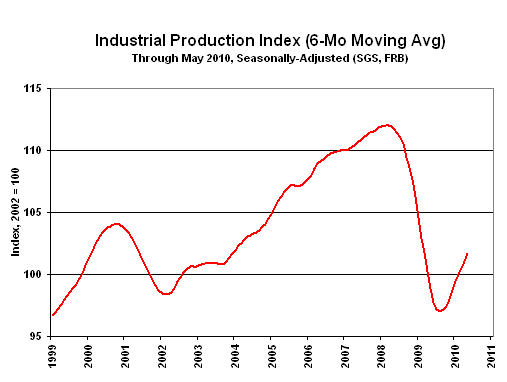
The "recovery" in production is shown in the above graph, where month-to-month volatility is smoothed using a six-month moving average. Production activity had leveled off at a low-level plateau of activity that effectively wiped out the last eight years of growth in industrial production. Despite the near-term upside bump generated by short-lived stimulus and seasonal distortions, the series likely still is bottom-bouncing and should begin to soften anew, significantly, in the next several months.
Home Sales (May 2010). May 2010 existing home sales are due for release on Tuesday, June 22nd, with new home sales scheduled for Wednesday, June 23rd. Given the expiration of home-buyer tax credits, these series should begin to fall-off sharply, reflecting sales lost to earlier periods. Both series will continue to suffer major distortions due to massive foreclosure rates, and reporting risk is to the downside of expectations.
New Orders for Durable Goods (May 2010). May durable goods orders are due for release on Thursday, June 24th. The recent benchmark revisions appear to have put an upside recovery bias into the monthly reporting. Nonetheless, the series should remain randomly volatile, with softer monthly numbers seen over time. Briefing.com shows a consensus forecast of a monthly contraction of 1.4% for May, versus the 2.8% gain reported initially for April.
Gross Domestic Product — GDP (First-Quarter 2010 — Third Estimate). The second revision to the first-quarter 2010 GDP estimate is due for release on Friday, June 25th. Likely to hold near the prior estimate of 3.0% annualized real growth, any revision likely will be no more than statistical noise.
___